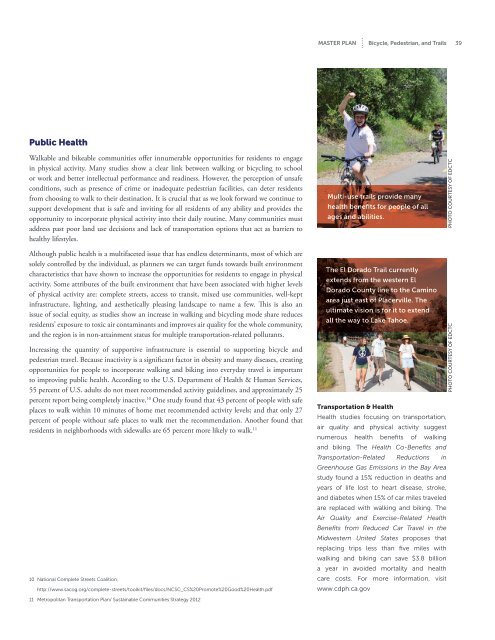Regional Bicycle, Pedestrian, and Trails Master Plan - sacog
Regional Bicycle, Pedestrian, and Trails Master Plan - sacog
Regional Bicycle, Pedestrian, and Trails Master Plan - sacog
You also want an ePaper? Increase the reach of your titles
YUMPU automatically turns print PDFs into web optimized ePapers that Google loves.
<strong>Master</strong> <strong>Plan</strong> <strong>Bicycle</strong>, <strong>Pedestrian</strong>, <strong>and</strong> <strong>Trails</strong> 39<br />
Public Health<br />
Walkable <strong>and</strong> bikeable communities offer innumerable opportunities for residents to engage<br />
in physical activity. Many studies show a clear link between walking or bicycling to school<br />
or work <strong>and</strong> better intellectual performance <strong>and</strong> readiness. However, the perception of unsafe<br />
conditions, such as presence of crime or inadequate pedestrian facilities, can deter residents<br />
from choosing to walk to their destination. It is crucial that as we look forward we continue to<br />
support development that is safe <strong>and</strong> inviting for all residents of any ability <strong>and</strong> provides the<br />
opportunity to incorporate physical activity into their daily routine. Many communities must<br />
address past poor l<strong>and</strong> use decisions <strong>and</strong> lack of transportation options that act as barriers to<br />
healthy lifestyles.<br />
Multi-use trails provide many<br />
health benefits for people of all<br />
ages <strong>and</strong> abilities.<br />
Photo Courtesy of EDCTC<br />
Although public health is a multifaceted issue that has endless determinants, most of which are<br />
solely controlled by the individual, as planners we can target funds towards built environment<br />
characteristics that have shown to increase the opportunities for residents to engage in physical<br />
activity. Some attributes of the built environment that have been associated with higher levels<br />
of physical activity are: complete streets, access to transit, mixed use communities, well-kept<br />
infrastructure, lighting, <strong>and</strong> aesthetically pleasing l<strong>and</strong>scape to name a few. This is also an<br />
issue of social equity, as studies show an increase in walking <strong>and</strong> bicycling mode share reduces<br />
residents’ exposure to toxic air contaminants <strong>and</strong> improves air quality for the whole community,<br />
<strong>and</strong> the region is in non-attainment status for multiple transportation-related pollutants.<br />
Increasing the quantity of supportive infrastructure is essential to supporting bicycle <strong>and</strong><br />
pedestrian travel. Because inactivity is a significant factor in obesity <strong>and</strong> many diseases, creating<br />
opportunities for people to incorporate walking <strong>and</strong> biking into everyday travel is important<br />
to improving public health. According to the U.S. Department of Health & Human Services,<br />
55 percent of U.S. adults do not meet recommended activity guidelines, <strong>and</strong> approximately 25<br />
percent report being completely inactive. 10 One study found that 43 percent of people with safe<br />
places to walk within 10 minutes of home met recommended activity levels; <strong>and</strong> that only 27<br />
percent of people without safe places to walk met the recommendation. Another found that<br />
residents in neighborhoods with sidewalks are 65 percent more likely to walk. 11<br />
10 National Complete Streets Coalition,<br />
http://www.<strong>sacog</strong>.org/complete-streets/toolkit/files/docs/NCSC_CS%20Promote%20Good%20Health.pdf<br />
The El Dorado Trail currently<br />
extends from the western El<br />
Dorado County line to the Camino<br />
area just east of Placerville. The<br />
ultimate vision is for it to extend<br />
all the way to Lake Tahoe.<br />
Transportation & Health<br />
Health studies focusing on transportation,<br />
air quality <strong>and</strong> physical activity suggest<br />
numerous health benefits of walking<br />
<strong>and</strong> biking. The Health Co-Benefits <strong>and</strong><br />
Transportation-Related Reductions in<br />
Greenhouse Gas Emissions in the Bay Area<br />
study found a 15% reduction in deaths <strong>and</strong><br />
years of life lost to heart disease, stroke,<br />
<strong>and</strong> diabetes when 15% of car miles traveled<br />
are replaced with walking <strong>and</strong> biking. The<br />
Air Quality <strong>and</strong> Exercise-Related Health<br />
Benefits from Reduced Car Travel in the<br />
Midwestern United States proposes that<br />
replacing trips less than five miles with<br />
walking <strong>and</strong> biking can save $3.8 billion<br />
a year in avoided mortality <strong>and</strong> health<br />
care costs. For more information, visit<br />
www.cdph.ca.gov<br />
Photo courtesy of EDCTC<br />
11 Metropolitan Transportation <strong>Plan</strong>/ Sustainable Communities Strategy 2012
















